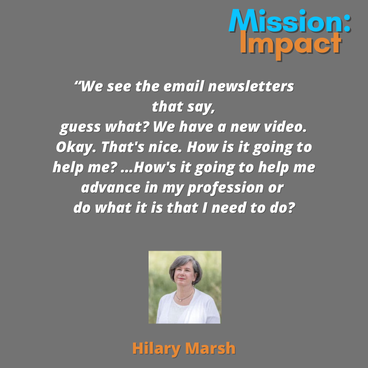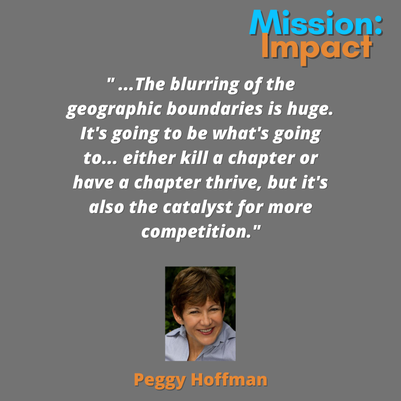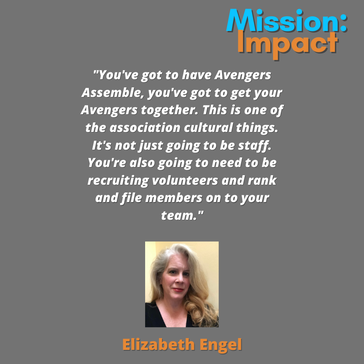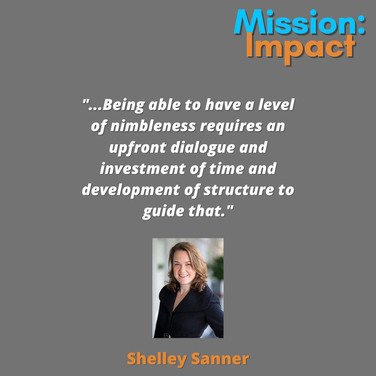Mission: Impact podcast & blog
Build a better world without becoming a martyr to your nonprofit cause
Listen on:
What is nonprofit strategic planning? Nonprofit strategic planning is a step-by-step process that helps you set priorities for your organization for the medium term – generally 3-5 years. You gather insight from your stakeholders, identify the common themes, explore possible futures and make decisions about where you want to focus your organization’s future in service of your mission. As part of the process you will clarify your why, what and how. What your nonprofit can expect from strategic planningStrategic planning is not about predicting or controlling the future. It is about creating greater alignment across your team, board, volunteers and all those who support the mission of your organization – creating a shared understanding and agreement about where you are headed. And at each stage, consider how equity factors into who you are including, whose voices are being heard and how decisions are being made. With this shared agreement on direction, you will be better prepared to make informed decisions about where to focus your energy and what your priorities are. A strategic plan is a process, not just a documentIt is also not just about the document – the strategic plan itself. That is a product of the process certainly. Yet it is really about the conversations that stakeholders have over the course of the process. Those conversations are what build the alignment and that shared understanding and ultimately the buy in that can be so elusive. It would be much easier and faster to decide one afternoon to “write” your organization’s strategic plan. Efficient for sure. Perhaps even satisfying for you as you are writing it. But ultimately that plan will fall short because it only represents your vision for the nonprofit organization. Nonprofit organizations are a collective effort. Typically tackling some of society’s biggest challenges. Getting closer to your organization’s mission effectively takes everyone pulling in the same direction and not working at cross purposes. Does my organization need a strategic planning retreat?It is also not just a retreat. Oftentimes, people will reach out and ask whether I can come facilitate their strategic planning retreat. But without the preliminary and fundamental step of discovery – or the listening tour – you do not have the grounding you need for a truly comprehensive and deep strategic planning process. Our 5-Step Nonprofit Strategic Planning Process for intentional, insightful, inclusive goal setting1. Your Strategic Plan kick-off onboardingHow you start the strategic planning project really makes all the difference. Getting clear about your goals for the project itself, who needs to be involved, the time frame you are planning for, as well as the strategic questions you are grappling with as an organization will set you up for success. Orienting the system to the processConsider holding a few kickoff events with your stakeholders to ensure that everyone is clear about how you are approaching the strategic planning process. Often this include sessions for staff, board, and other volunteers. These events typically include an overview of the project and process, who will be involved including any consultants you have hired to support and guide the process, as well as a conversation about what people are hoping for in the process and what their concerns are. After the event, it is very helpful to send a written document to everyone that reiterates the same information so that everyone has something to refer back to as the project progresses. Assembling your teamOne of the first tasks is to pull together a group of staff and board that will form your strategic planning committee or task force. The job of this group is to steward the process and advise on key decision points along the way. It is NOT their job to make all the decisions about the final three-five goals that will make up the main elements of your actual strategic plan. Who should be on the strategic planning task force? Board, leadership, staff?The task force should include people empowered with the organization to make decisions. This typically means the executive director, the board chair and ideally the incoming board chair as well as staff and other volunteers who will be influential about your organization’s future. A smaller group will find it easier to make decisions (up to five people). With a larger group (up to nine people) you will be able to better represent different elements of the organization and your stakeholders, yet you may need to have a smaller group designated to have the final say on decisions. What is the role of the strategic planning task force?Some of the task force’s tasks at the beginning of the process include identifying the stakeholders who are vital to your organization's future, how input from them will be gathered and what questions you will be asking them. Who is important to shaping your organization’s future? Often stakeholders include staff, board, volunteers, community partners and allied organizations, as well as those your organization serves and funders. Have you fully considered power dynamics as you prioritize stakeholders? How do you plan to gather input from those stakeholders who are part of historically marginalized communities? What supports may they need to fully participate in the process How a nonprofit strategic planning consultant can helpWhen you are working with a consultant, they will help you sketch this out as well as support you in making decisions about how the information will be gathered. You will need to decide whether it is with one-on-one interviews, focus groups and/or surveys. Deciding what mix of approaches makes sense in your organization’s situation is one of the key tasks for the group during the kickoff phase. Once those decisions have been made, the discovery phase or listening tour can start. 2. Discover: Listen to your key stakeholders before you start making decisions!This step in the process you are going on a listening tour to discover what is the organization’s current state, what are its strengths, challenges, what is its history and what are the collective hopes and aspirations for the organization’s future. One of the benefits of working with a consultant is that they can take on the time-intensive work of talking one-on-one with people, facilitating focus groups and developing, launching and analyzing surveys. In addition, consultants will often have a bank of questions that they will use as a spring board to customize for your situation. If you choose to conduct the input process yourself, be sure to orient your volunteers to how to conduct interviews and be clear about the process for capturing notes so that the results can be analyzed into themes. How are you making participation in your accessible for community members?Another consideration when you are conducting your listening tour is to think through the systemic barriers that may prevent those you serve and support from participating in your listening opportunities. How will you make it possible and accessible for people you serve to participate? Will you offer stipends, feed people, provide or reimburse transportation and child care? If your input sessions are being held virtually, do people have the digital access needed to participate? 3. Explore your stakeholder insights, wider trends and your potential futuresOnce you have a solid picture of where you are as an organization, your strengths and challenges, what some of the aspirations are that people have for the organization, you will need to share these findings with your planning group so that they can make meaning of them. The planning group should include your board and staff. This is the group that you will gather at a strategic planning retreat or over a series of strategic planning sessions. What can you expect during a strategic planning retreat or strategy planning sessions?A strategic planning retreat will typically start with an overview of the findings from the listening tour and then time for small group and large group discussion of what meaning the group makes of the findings. Other agenda items will likely be an exploration of wider trends, envisioning the organization's future, identifying major goals, action steps and success indicators, identifying key criteria for future decision making as well as a review of your organization's mission, vision, values to update them as necessary. The retreat itself will be a mixture of small and large group conversations and activities. Multiple ways of knowing and communicating should be included, such as drawing, skits and other ways to tap into everyone's imagination. There should also be time for individual reflection and group dialogue to be inclusive of varying thinking and communicating styles. A series of online strategy sessions will typically range from 90 minutes to three hours at a time and use a combination of a video conference platform such as Zoom with work being done digitally through a google doc or Mural board or other online white board tool. Why its important to explore the wider environment and trendsWith the foundation of what the current state of the organization is, the group should also look wider and identify the wider trends impacting your organization. Your organization does not exist in a vacuum. It exists in a wider ecosystem of the community you are in, the field you are in, as well as the wider society and world. What trends does the group see politically, economically, socially, environmentally, and technologically? Of those trends, which ones will most likely have an impact on your organization furthering its mission. Imaging the future of your nonprofit organization With this wider perspective in mind, lead the group in a variety of exercises to help them imagine a new future for the organization. Think about how you can integrate different ways of knowing into your exploration process. Get beyond just words and integrate opportunities to bring in different senses and modalities such as drawing, skits, and songs. This is the part of the exploration process when you can let the imagination fly freeing and think audaciously. All these possibly wild ideas and aspirations will likely not make it into the final plan yet they help uncover new options that the group might not otherwise consider. 4. Decide your nonprofit priorities, based on mission, vision & valuesYou now have fun and inspiring pictures of potential futures for the organization. Unfortunately too often this is where people often stop. And then they wonder why they feel overwhelmed by a ‘plan’ that looks more like a wish list. Setting priorities for your nonprofit organizationYou then need to lead the group through a series of exercises to set priorities and make decisions about which of these options you will put your energy behind. You cannot do everything. This is another element of the process that is especially helpful to have the support of strategic planning consultants. They have no agenda about what ultimately gets decided and prioritized – instead they have expertise in helping groups have effective conversations about options and actually make decisions. As you are making those decisions, consider whose voice is being prioritized and how each decision might impact different groups you serve. Update your mission and visionYou may have noticed that I did not start the process with a mission and vision exercise. This is where many other strategic planning consultants start. I recommend instead that groups refine their mission and vision statements at the end of the process. You then benefit from all the conversations that the group has had over the course of the process, and it is more a matter of confirmation. Does your current mission statement accurately reflect where the organization is going? Does your vision statement accurately describe the change you are trying to make in the world? What needs to be updated or refined? 5. Plan & Act: Turn your strategies into action steps not a wishlistSuccess indicatorsOnce you have decided on three and up to no more than five big goals, lead the group through conversations to identify what action steps will move those goals forward. Provide ways for feedback to be gathered. You may need to go through several iterations. For each action step, also define what success will look like. How will you know you have made progress? The strategic planning task force will take the rough draft created by the larger planning group, clean up the language and do the final refinement so that it is clear. Check one last time for shared agreement with the larger group. Operationalizing your nonprofit strategic planUsually your board will vote on the final version of the plan and approve it. Having been closely involved in each step of the process, and provided multiple opportunities for input and feedback, this approval ideally is a straightforward process. Staff then need to operationalize the plan and decide who is going to do what, by when, in Year one. The process of creating an annual implementation plan will include what are you focusing on in year one – what needs to happen first? And what are more specific tasks that need to happen to move your action steps forward? Keeping the plan freshYou now have a strategic plan and a year one implementation plan that captures the shared agreement among your stakeholders about where you are going to put your energy to move your mission forward more effectively. Yet the world does not stand still – new opportunities and challenges will emerge. Before you are finished with your process, work with your strategic planning task force to agree on how you keep track of the plan. How will you integrate it into regular planning practices? Board meetings, staff meetings? Keep track of progress? Evaluate when you need to make adjustments and updates? Get clear and come to agreement about what your practice is for keeping the plan relevant and front of mind. You will be continuously learning and adapting. Goals that truly help an organization forward are dynamic and require ongoing effort, reflection, and adaptation to changing circumstances and new understandings. Reconnecting with your external stakeholder groups You also need to think about how you will share the summary of the input gathered to your wider stakeholders who may not be part of the planning sessions themselves. You asked for their input – help them understand how you are going to use their information. Your goal in gathering input from them is not only to gain their perspective but also to engage them in the future of your organization. Do not undermine the trust you have built by asking them for input and then not closing the loop and sharing some version of the findings summary. Building buy in through engagementStrategic planning is an opportunity to do a deep engagement with your stakeholders to get them excited about and shape the future of your organization. Using the five-step process – kick off, discover, explore, plan and act, plus deciding on a process for keeping the plan fresh will create the level of buy in you need to have your plan be relevant and usable for guiding your organization’s future.
 In episode 30 of Mission: Impact, some of the topics that Carol and her guest, Hilary Marsh discussed include:
Important Guest Links:
Click "Read More" for Transcript:  In episode 28 of Mission: Impact, some of the topics that Carol and her guest, Peggy Hoffman discussed include:
Peggy Hoffman is president of Mariner Management, an association management company which is home to two associations and provides an array of support and training to associations and most importantly member volunteers. Peggy has provided training and counsel to dozens of global, national and local membership associations over the past 30 years. She often draws on her own team’s research on volunteerism, member communities and association innovation. Peggy not only enjoys working with association volunteers but is an active volunteer for her professional association – including serving as a chapter past president – so she’ll draw from experience on both levels. Read her full bio at MarinerManagement.com and connect with Peggy on Twitter @peggyhoffman or LinkedIn. And ask her about triathlons, dance or living with three sons. Important Guest Links:
Click "Read More" for Transcript:  In episode 23 of Mission: Impact, some of the topics that Carol and her guest, Elizabeth Engel discussed include:
Elizabeth Weaver Engel, M.A., CAE, is Chief Strategist at Spark Consulting. For more than twenty years, Elizabeth has helped associations grow in membership, marketing, communications, public presence, and especially revenue, which is what Spark is all about. She speaks and writes frequently on a variety of topics in association management. When she's not helping associations grow, Elizabeth loves to dance, listen to live music, cook, and garden. Important Guest Links:
Contact Us:
Click "Read More" for Transcript:  In episode 18 of Mission: Impact, some of the topics that Carol and her guests, Shelley Sanner and Alanna McKee discussed include: - Trends facing associations, including the need for greater personalization - How associations have adjusted to the virtual environment - What the future of work could like and how associations could contribute to the workforce development of the fields they serve Guest Information: Shelley Sanner, CAE, MA, Senior Vice President, Industry Relations: As senior vice president of industry relations, Shelley fosters knowledge-sharing and partnerships to promote innovation and excellence within the association industry. Her main areas of focus include identifying association challenges and trends and translating them into resources that benefit the community at-large. She also coordinates McKinley’s presence at events and within industry publications to ensure that we serve as a resource to the community on best practices and other insights. Before joining McKinley in 2007, Shelley served as Membership Director at a higher education association. On a national level, Shelley has served in various volunteer leadership positions, taught courses and presented at many industry events. She has a Master’s in liberal studies from Georgetown University and an undergraduate degree from Juniata College, where she majored in French and education. Alanna Tievsky McKee, MSW, Director: As a director within the consulting department, Alanna leads client engagements designed to maximize organizational efficiency and mission impact. She brings a creative and thoughtful approach to each of her clients, combining skills acquired through her training and experience as a consultant, clinician, and coach. During her time at McKinley, she has nurtured an expertise in member engagement and retention, strategic planning, governance and staff and volunteer leadership facilitation. Alanna has worked in and with the nonprofit sector for more than a decade and has supported nearly 100 unique associations as a member of the McKinley team. She is a social worker by trade and feels passionate about helping individuals and organizations solve challenges and reach their full potential. Alanna holds an MSW from the University of Pennsylvania with a concentration in nonprofit management and a B.A. in developmental neuropsychology from the University of Rochester. Contact our Guests
|
Categories
All
Archives
July 2024

Grace Social Sector Consulting, LLC, owns the copyright in and to all content in and transcripts of the Mission: Impact podcast, as well as the Mission: Impact blog with all rights reserved, including right of publicity.
|
Telephone301-857-9335
|
info[at]gracesocialsector.com
|
Grace Social Sector Consulting, LLC, owns the copyright in and to all content in, including transcripts and audio of the Mission: Impact podcast and all content on this website, with all rights reserved, including right of publicity.
|